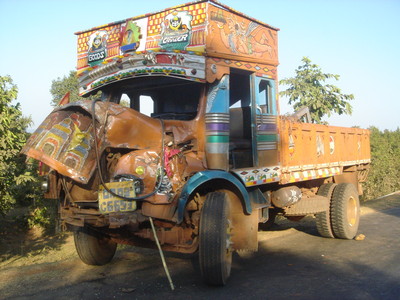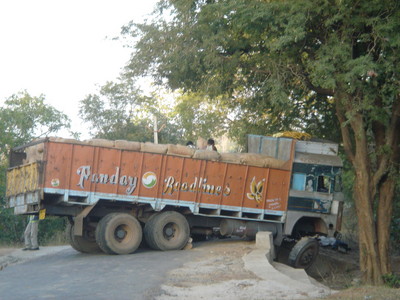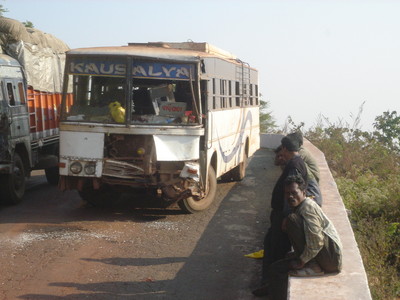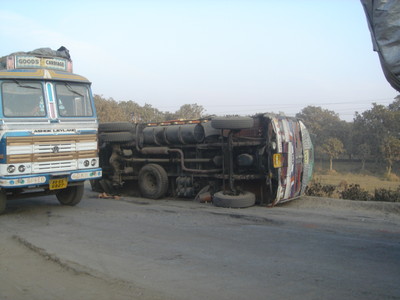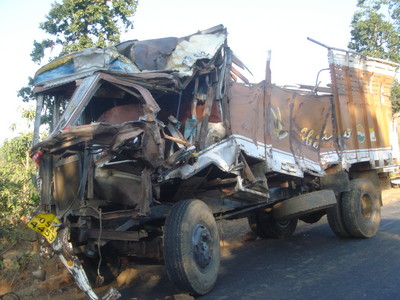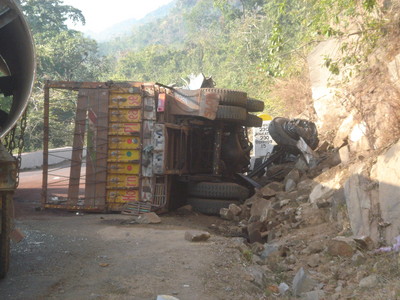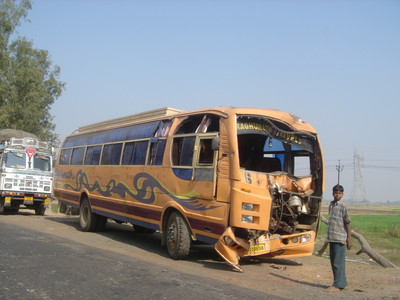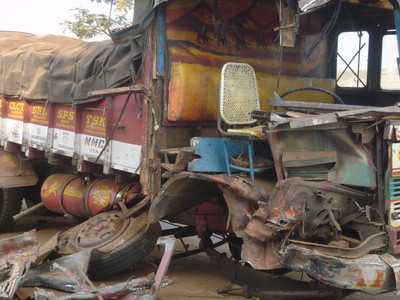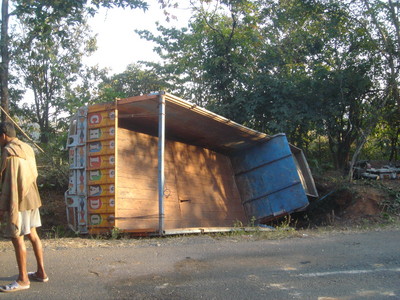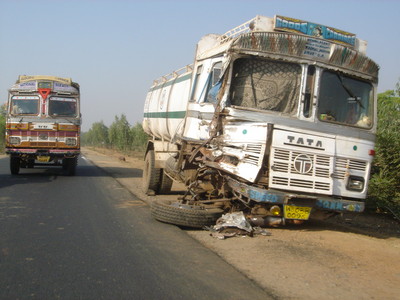Mercy Corps was the chosen charity of the Rickshaw Run. The bulk of the money raised went to buy the Rickshaws that are being taking down to Siliguri as I write this. As it stands, some of these will be sold with the funds going to some of the Mercy Corps supported NGO’s, some will be donated to projects in Siliguri (one for instance is becoming the school bus for handicapped children) and others will be donated to needy families so that they can start to make a living.
Any of the cash raised over the initial 650 goes to Mercy Corps projects in the Darjeeling district. Given that Espe and I had more time than most teams, we wanted to go to see some of these NGO’s at work. Tom put us in contact with John Strickland at Mercy Corps’ who arranged for us to spend a few days in the mountains with one of his teams.
On Monday 15th we set off in a jeep to Upper Lington. Although only a mere 41km from Darjeeling, the drive took two and a half hours due to the twisty potholed roads. Throughout the journey and upon arrival I was stunned by the beauty of the place. We were in one of many communities in the Himalayan foothills (Mercy Corps work with communities based on tea estates, forests and agricultural areas close to Darjeeling) and very much off the beaten track.
We were introduced to the family we would be staying with, shown around their beautiful home (although basic, it catered for their needs and was expertly built from local materials) and given a wonderful cup of chai. We were then shown around the local community while Raju, one of the Mercy Corps workers, explained how up in the agricultural hills how the communities are very close knit and help each other out immensely.
Each household has a small slot of land on the steep slopes. These are all converted into terraces to enable crops to be grown and animals to graze. The crops like potatoes, carrots, spices, corn are pretty much only for personal consumption or to be exchanged for products grown further down the mountain like rice. If one household has a bad yield, illnesses or other problems, then the community will come together to help. This seems a damn sight more civilised that what we know of the civilised world.
We were shown to a small cheese factory that had been built buy some of the community members as part of a Mercy Corps project. This provides sustainable income for both the farmers who provide the milk and the workers who produce the cheese and butter. We were then invited into the owners home for yet more chai.
We then moved onto Karmi Farm which, veranda and all, appeared to date back to colonel times. The owners originally owned much of the land in the area before independence. The farm as we found out from the current owner, a friendly half British half Nepali women, has a lot of history. The farm is now a wonderful holiday retreat. If it were not for their high prices we would have loved to have stayed a few days longer in the utmost tranquility of the place. Reading on the Veranda and taking walks in the countryside. Check out their website. www.karmifarm.com.
As Raju continued to explain, most of the produce from the farms is there for personal use. This is how they survive. Very little is sold on. The sources of income for the families are limited. One such source is the spcie Cardamom which grows in the area. This until recently was one of the biggest sources of income, but a disease that has spread with the plant throughout the region in recent years has left the area with smaller yield and hence economic problems.
The other main source of income is brooms. These are made from another plant that grows wild in the area. Each broom fetches about 5 rupees (about 6 pence).
The following two days we went with the Mercy Corps team to two different communities, Sirisay and Lower Colbong, to see the team in action. The walk down the hills to both villages were stunning. About 45 minutes down twisty little paths passing through small farms and jungle. Coming back up again was quite hard work.
In both these communities Mercy Corps are striving to set up projects with the community based on what the community wants (communities range from 10 to 100 households). In both places we witnessed two meetings take place. There was general discussion about what Mercy Corps could offer, what was expected from the community and the setting up of a committee within the community (decided by the community)
The three main issues these projects try to address are health, youth (education) and economic development.
On the health front a Community Health Worker is appointed and provided with basic training. This enables small problems to be address and more serious issues spotted early on. Another example of health improvements in the communities we visited were toilets that have been built for the households. Money for the materials not available locally was fronted by Mercy Corps, while local materials and labour was provided by the local community. Although it may not seem like much, the benefits of a toilet for the households are three fold. They provide sanitary conditions, prevent pollution and illness down stream and provide manure which in turn gives more fertile ground.
The youth projects focus on providing better primary education, attempt to get children into secondary education (which due to financial restraints and the remoteness of the villages proves very difficult) and and provide business training for young adults. We saw the results of a local school that had been completely rebuilt only last year.
The third area of focus is that of economic development. Something that is needed in the region, especially with the current cardamom problems.
Some examples of these that were illustrated to us (both current and forthcoming) included a community shop that enables locals to get produced that could take upwards of four hours to procure previously, carpentry works, a paper mill (a pending project) and tourist village home stays (an idea that has been encouraged by our reaction to our experiences).
Without going into too much detail, Mercy Corps work with the communities by encouraging the people to elect representatives, discuss the needs of the community and then assist the community on deciding what needs tackling first. At this point the locals become involved in building / setting up of the solution be it schools, latrines or small factories.
Unlike those working in the tea states, those in agricultural regions can just about get buy on the food they produce on their small mountainside farms. They need income however to buy produce and commodities that they are unable to produce. What we saw was quite well off compared to those of the tea states who experience and much harder life style. They are exploited by the plantation owners, they do not own any of the own land and due to work have very little time to attend meetings.
Personally I was blown away by the whole experience. Firstly the location, the remoteness and beauty of it was overwhelming. Secondly seeing how the people coped so well with what they did have was mighty impressive. What impressed me most of all though, was the cooking of our hostess (yup, thinking of my stomach as ever). Locally grown freshly cooked on a wooden food, the Indian dishes cooked by Bindu were simply sublime. As Espe said at our first meal, “this is the best food I’ve eaten in India”
Time for some words of appreciation.
Thank you to all those who sponsored us as part of the Rickshaw Run. We’ve raised 930 pounds to date plus the giftaid and there are still a few more promises to be chased up on. Getting the money together to enable us to take part in the event was amazing, but actually seeing where and how the money will be spent was something else. I only wish I could share better with you via this blog what we’ve seen.
Thanks to John and the Mercy Corps team in Darjeeling, especially Raju who explained everything to us and some. Without his commentary and introductions the trip would not have been half of what it was (and I’d have very little to write about here).
Finally I’d like to pass on some thanks from Raju and some of the villagers we met. A huge thank you to all those who took part in the Rickshaw Run. Firstly for the brave efforts in the Rickshaw Run in raising so much cash for charity. Secondly, for bringing the rickshaw run to Darjeerling. Raju truly believes that this is very good for his home town and will welcome the run back next year when it is sure to grow from strength to strength.
To find out more about Mercy Corps projects in India take a look at www.mecrycorps.org.uk
